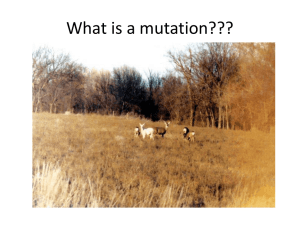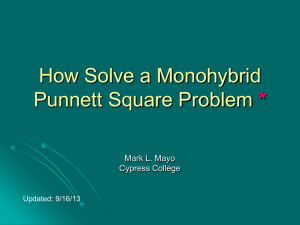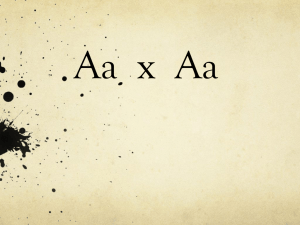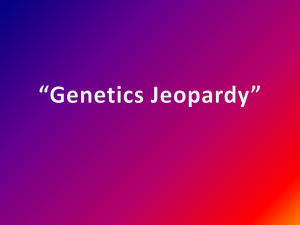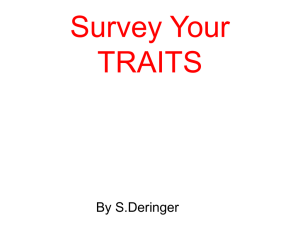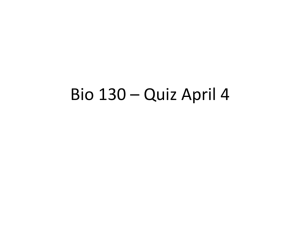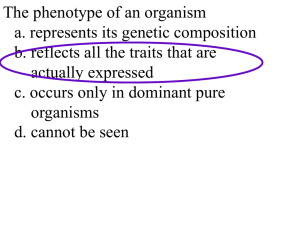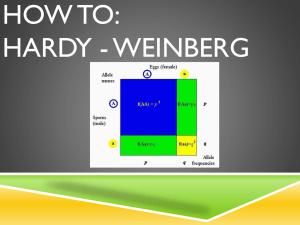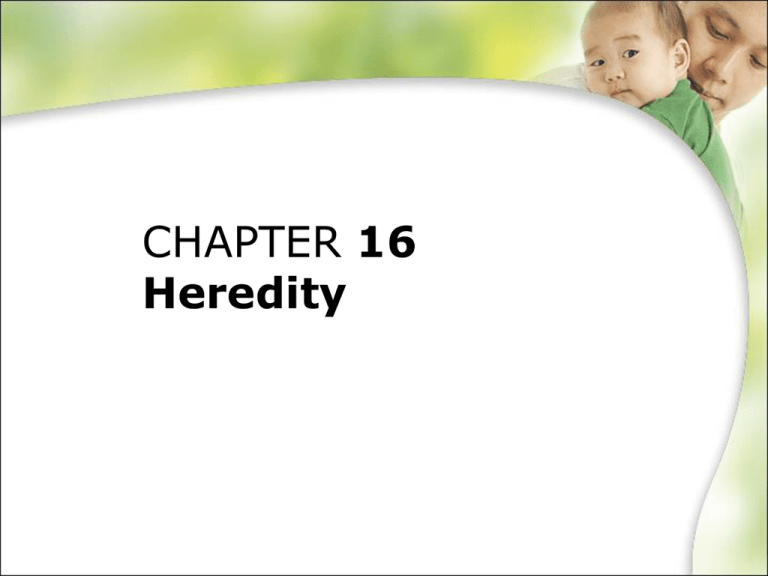
CHAPTER 16
Heredity
Chapter
16
Heredity
16.1 Heredity
16.2 Basic Knowledge for Studying Heredity
16.3 Determining Genotypes
16.4 Discontinuous and Continuous Variations
16.5 Mutation
Why do Animals look the same?
16.1
Heredity
Learning Outcome
After this section, you should be able to:
• understand genetics and monohybrid inheritance.
16.1
Heredity
Hereditary traits
• A hereditary trait is a characteristic that can be
passed on from one generation to another.
• Examples include:
-
Hair type
Shape of earlobe
Eye colour
Face shape
Chin shape
Ability to roll tongue
Skin colour
Blood type
16.1
Heredity
What is Genetics?
Genetics is the study of the inheritance of
characteristics by transmission of genetic
materials from one generation to another.
Gregor Mendel, the
founding father of
modern genetics
studied monohybrid
inheritance in peas.
16.1
Heredity
What is monohybrid inheritance?
• Monohybrid inheritance refers to the inheritance
of one characteristic that has TWO contrasting
forms.
• Each characteristic is
controlled by a single gene.
gene
• Each gene consists of a
pair of alleles.
alleles
• Alleles can be dominant
or recessive.
homologous
chromosomes
16.1
Heredity
Mendel’s monohybrid experiment
Mendel crossed pure-bred tall pea
plants with pure-bred dwarf plants.
He planted the seeds from the cross
and observed that the resulting F1
generation hybrids are all tall plants.
tall
dwarf
tall
tall
tall
tall
dwarf
He allowed the F1 offspring to
self-fertilise and produce
seeds.
The seeds from the F1 offspring
gave rise to the F2 generation,
which produced a ratio of three tall
plants to one dwarf plant.
16.1
Heredity
Mendel’s monohybrid experiment
Mendel named the trait that always appeared
in the F1 hybrids (tall) dominant and the other
(dwarf) recessive.
dominant
trait
recessive
trait
16.1
Heredity
Mendel’s model of heredity
• Hereditary factors (genes) are responsible for the
transmission of characteristics.
• Each characteristic is controlled by a pair of factors in the
cells.
• If the two factors are different, only the dominant factor
will show its effect.
• The two factors separate (segregate) during gamete
formation. Each gamete will only contain one factor
(Law of Segregation).
• The random fusion of gametes
formed contains two factors.
ensures that the zygote
16.1
Heredity
Mendel’s Law of Segregation
Chapter
16
Heredity
16.1 Heredity
16.2 Basic Knowledge for Studying Heredity
16.3 Determining Genotypes
16.4 Discontinuous and Continuous Variations
16.5 Mutation
16.2
Heredity
Learning Outcomes
After this section, you should be able to:
• understand the terms gene, allele, dominant,
recessive, homozygous, heterozygous, phenotype
and genotype;
• use genetic diagrams to explain monohybrid
inheritance.
19.2
Basic Knowledge for Studying
Heredity
Chromosome
A chromosome is a rod-like structure visible in
the nucleus during cell division.
It is made up of the molecule
deoxyribonucleic acid (DNA).
19.2
Basic Knowledge for Studying
Heredity
Gene
A gene is a unit of inheritance, born
on a particular locus (position) of a
chromosome.
It is a small segment of DNA in a
chromosome that controls a
particular characteristic or protein in
an organism.
gene locus
chromosome
19.2
Basic Knowledge for Studying
Heredity
Alleles
Alleles are different forms of the same
gene.
They occupy the same relative positions
on a pair of homologous chromosomes.
Letters are usually used to represent
alleles.
T
t
19.2
Basic Knowledge for Studying
Heredity
Homologous Chromosomes
gene locus
Homologous chromosomes
exist in pairs.
One chromosome in the pair
comes from the male parent
and the other from the female
parent.
They have exactly the same
sequence of gene loci.
paternal
chromosome
maternal
chromosome
16.2
Basic Knowledge for
Studying Heredity
Introduction to terms
nucleus
chromatin
gene
different
gene loci
cell
homologous
chromosomes
16.2
Basic Knowledge for
Studying Heredity
Introduction to terms:
Phenotype
• The phenotype of an organism refers to its
observable traits.
• The phenotype of an organism is influenced by:
– its genotype
– the environment
URL
16.2
Basic Knowledge for
Studying Heredity
Introduction to terms:
Genotype
• The genotype is the genetic make-up of an
organism which is inherited from its parents.
• An organism is homozygous for a trait if the two
alleles controlling the trait are the same. The possible
homozygous combinations are:
– homozygous dominant (e.g. TT)
– homozygous recessive (e.g. tt)
• An organism is heterozygous for a trait if the two
alleles controlling the trait are different (e.g. Tt).
16.2
Basic Knowledge for
Studying Heredity
Introduction to terms:
Dominant and recessive alleles
• Alleles can exist in dominant or recessive forms.
Dominant allele
is represented
with an upper
case letter.
Recessive allele is
represented with
the corresponding
lower case letter.
• A dominant allele expresses itself in both
homozygous dominant and heterozygous conditions.
• A recessive allele will only express itself in a
homozygous recessive genotype.
Basic Knowledge for
Studying Heredity
16.2
Introduction to terms:
Dominant and reccessive alleles
P
a a
Q
R
Phenotype:
physical
characteristic of
the organism
A A
A a
Genotype:
genetic make-up
of the organism
homozygous
(pure-breeding)
heterozygous
(hybrid)
Why do plants Q and R look the same
when they have different genes?
16.2
Basic Knowledge for
Studying Heredity
Modelling genetic crosses
• Genetic models can be used to:
- explain how alleles are passed on to an offspring
- predict the traits that will be displayed by an
offspring
• The next slide uses the genetic model to explain
Mendel’s monohybrid experiment on tall and
dwarf plants.
16.2
Basic Knowledge for
Studying Heredity
Genetic diagram
Basic Knowledge for
Studying Heredity
16.2
The Punnett square
• The Punnett square is a simpler method to determine
or explain genetic crosses.
• The Punnett squares for Mendel’s monohybrid experiment:
Parents
TT
F1 hybrid self-cross
tt
Tt
Tt
Gametes
t
t
Gametes
T
t
T
Tt
(tall)
Tt
(tall)
T
TT
(tall)
Tt
(tall)
T
Tt
(tall)
Tt
(tall)
t
Tt
(tall)
tt
(dwarf)
Chapter
16
Heredity
16.1 Heredity
16.2 Basic Knowledge for Studying Heredity
16.3 Determining Genotypes
16.4 Discontinuous and Continuous Variations
16.5 Mutation
16.3
Determining Genotypes
Learning Outcomes
After this section, you should be able to:
• use a test cross to predict an unknown phenotype;
• describe sex determination in humans.
16.3
Determining Genotypes
Determining genotypes
• When an organism displays the recessive trait,
the organism is a homozygous recessive.
• However, when organisms display the dominant
trait, the organism could be a heterozygous or a
homozygous dominant.
• Breeding experiments are used to identify the
genotype of an organism.
16.3
Determining Genotypes
Test cross
A test cross is used to determine the genotype of an
organism with dominant trait by crossing the organism
with a homozygous recessive organism.
•
If the organism is homozygous dominant, all the
offspring should show the dominant trait.
Phenotypes
and genotypes
of parents
Gametes
Phenotype
and genotype
of offspring
homozygous dominant
tall
TT
homozygous recessive
T
tt
t
Tt
all tall
dwarf
16.3
Determining Genotypes
Test cross
•
If the organism is heterozygous, half the number of
offspring should show the dominant trait. The
remaining half should show the recessive trait.
Phenotypes
and genotypes
of parents
heterozygous
homozygous recessive
Tt
tt
Gametes
T
t
t
Genotypes
of offspring
Tt
Ratio of phenotypes
tall
tt
1 tall : 1 dwarf
dwarf
16.3
Determining Genotypes
Sex determination
• Sex chromosomes are chromosomes that determine
the sex of an organism.
• Autosomes are chromosomes in cells other than the
sex chromosome.
• There are two types of sex chromosome:
– X chromosome
– Y chromosome
• Cells that produce gametes by meiosis are known as
sex cells. The other cells in the body are known as
somatic cells.
16.3
Determining Genotypes
Sex determination
• Humans have 22 pairs of autosomes and one pair
of sex chromosomes (XY - male or XX - female)
in each cell.
• Male gametes (sperms) contain either the
X chromosome or Y chromosome.
• Female gamete (eggs) contain only the
X chromosome.
• Whether an X-carrying sperm or a Y-carrying sperm
fertilises the ovum determines the sex of the zygote.
URL
16.3
Determining Genotypes
Sex determination
When male and female gametes fuse during
fertilisation, there is an equal chance that the
offspring could be a male or a female.
male
female
X
XY
Parents
XX
Gametes
X
Y
X
X
Offspring
XX
XX
XY
XY
females
males
3.6 What are gametes haploid?
• Differences in cell division
• Somatic cells (growth, repair)
– Mitosis
– Produces 2 identical diploid cells
– Daughter cells have the same number and kinds of
chromosome as parent cell
• Gametes (Ovaries + Testes)
– Meiosis
– Produces 4 haploid daughter cells
– Each daughter cell has ½ number of chromosomes
as the parent cell
3.6.1 Relationship between mitosis, meiosis and fertilization
3.5.1 Think about this
• Is this a haploid/diploid cell?
• Is this a male or female?
3.5.2 What happens if . . . .
• Male : XXY
– Klinefelter syndrome
3.5.3 What happens if . . . .
• Male : XYY
– Jacob's Syndrome, Supermale Syndrome
• Signs and symptoms
– learning problems at school
– delayed emotional maturity
– tall, thin, have acne, speech problems, and
reading problems.
3.5.4 What happens if . . . .
• Female : X
– Turner
syndrome
Chapter
16
Heredity
16.1 Heredity
16.2 Basic Knowledge for Studying Heredity
16.3 Determining Genotypes
16.4 Discontinuous and Continuous
Variations
16.5 Mutation
16.4
Discontinuous and
Continuous Variations
Learning Outcome
After this section, you should be able to:
• compare and provide examples for continuous and
discontinuous variation.
16.4
Discontinuous and
Continuous Variations
Variations
• Variations are differences in traits between
individuals of the same species.
• The traits of an individual is dependent on
interactions between the genes and the
environment.
• Genetic variation is heritable, but variations due to
the environment are not.
1.2.1 What is variation?
• Differences observed among individuals
within a species
• Types of variations
– Continuous variation
– Discontinuous variation
1.2.2 What is continuous variation?
• Characteristics that vary gradually from one
extreme form to the other
• No clearly defined groups ; with a large range of
values
• Examples of traits:
– Human height,
– Weight,
– Intelligence
• Controlled by several genes
• Influenced by environment, lifestyle, diet,
exercise
Continuous Variation
Length of feet
Height
1.2.3 What is discontinuous variation?
• Characteristics that show no intermediate forms
• Clearly defined groups
• Examples of traits :
–
–
–
–
–
attached earlobes or free earlobes,
blood group,
tongue rolling,
colour blindness,
ability to taste phenylthiourea (PTU)
• Controlled by a single gene
• Not influenced by environmental factors
Discontinuous variation
Cleft chin
Attached or free earlobes
Tongue
roller
Widow’s Peak
Continuous variation vs Discontinuous variation
Discontinuous variation
Continuous variation
Discontinuous and
Continuous Variations
16.4
Variations
• Discontinuous variation is brought about one or
a few genes.
• Continuous variation is brought about by the
additive effect of many genes.
double-eyelids
single-eyelid
Continuous variation
Number of individuals
in a population
Number of individuals
in a population
Discontinuous variation
Dark skin
Fair skin
16.4
Discontinuous and
Continuous Variations
Comparing discontinuous and
continuous variations
Discontinuous variation
Deals with a few clear-cut
phenotypes
Continuous variation
Deals with a range of
phenotypes
Controlled by one or a few
genes
Controlled by many genes
Genes do not show additive
effect
Not affected by environmental
conditions
Examples include eye colour
and blood group
Genes show additive effect
Affected by environmental
conditions
Examples include height and
skin colour
Chapter
16
Heredity
16.1 Heredity
16.2 Basic Knowledge for Studying Heredity
16.3 Determining Genotypes
16.4 Discontinuous and Continuous Variations
16.5 Mutation
16.5
Mutation
Learning Outcomes
After this section, you should be able to:
• explain mutation as a change in the structure of a
gene such as in sickle-cell anaemia, or in the
chromosome number, such as in Down’s
syndrome;
• understand that radiation and chemicals are
factors which may increase the rate of mutation.
16.5
Mutation
Types of mutation
• Mutation occurs as a result of error during the
replication of the gene or chromosome.
• Somatic mutations that occur in normal body
cells cannot be inherited.
• Mutations may be inherited by the next generation
if they occur in cells that give rise to gametes.
• Dominant mutations are easily detected unlike
recessive mutations, which may not be detectable
for generations.
16.5
Mutation
Types of mutation
• Chromosome mutation
– change in the structure or number of chromosomes
– causes Down’s syndrome
• Gene mutation
– change in the structure of DNA
– produces variation between individuals as it results
in new alleles of genes
– causes albinism and sickle-cell anaemia
Mutation
• Gene Mutation
– Deletion
– Addition
– Substitution
– Switching on/off genes expression
• Chromosomal
– Addition
– Deletion
16.5
Mutation
Chromosome mutation
Down’s syndrome
• Humans normally have 46 chromosomes in their
body cells.
• People with Down’s syndrome have 47
chromosomes.
• They have an extra copy of chromosome 21.
16.5
Mutation
Chromosome mutation
Down’s syndrome
• Chromosome mutation in the gametes of a female
parent can produce a child with Down’s syndrome.
Male
Female
X
Normal body cell
has two copies of
chromosome 21
One of the eggs
has two copies of
chromosome 21
mutation
Zygote formed has
three copies of
chromosome 21
16.5
Mutation
Gene mutation
Albinism
• Caused by mutation in a recessive allele
• The absence of the pigment melanin results in
reddish-white skin, white hair and pink eyes.
• Albinos get sunburn easily as they are very
sensitive to sunlight.
16.5
Mutation
Gene mutation
Sickle-cell anaemia
• Caused by mutation in the gene controlling
haemoglobin production
• The mutated gene is recessive, hence only
expressed in homozygous recessive condition.
• Sickle-shaped red blood cells have low oxygen
carrying capacity and tend to clump together.
• This disease is fatal and sufferers usually die young.
16.5
Mutation
Gene mutation
Sickle-cell anaemia
• Individuals who are heterozygous for the sickle-cell
allele are more resistant to malaria.
• Hence, heterozygous individuals are common in
areas where malaria is prevalent such as West
Africa.
16.5
Mutation
Mutation and selection
• Mutations can be harmful or beneficial.
- Individuals with harmful mutation will be eliminated.
- Individuals with beneficial mutation on the other hand
may leave more offspring than normal individuals.
• Nature ‘selects’ organisms with more favourable
characteristics to survive and reproduce.
16.5
Mutation
Natural selection
• Natural selection is a process that ensures the best
adapted organisms in a population survive to reproduce
and pass on their genes to the next generation.
• Nature selects varieties of organisms that are:
– more resistant to diseases
– better adapted to changes in the environment
• The process by which present complex forms of living
organisms have arisen from simpler ancestral forms is
known as evolution.
•
•
•
•
•
Causes of Mutation
Age of Cell (Wear & Tear of DNA
replication machinery)
Crossing over of genes between synapsis
in Meiosis
Mutagens (Cancer causing Agents)
Radiation
Virus
5.4.1 Dominant and recessive allele
Characteristic
PTC-tasting
Tongue-rolling
Earlobes
Dominant allele
T
R
E
Recessive alle
t
r
e
• Let R represent dominant allele for tongue-roller
• Homozygous
Let r represent
recessive allele
dominant
R Rfor non-tongue-roller
Tongue-roller
Heterozygous
Rr
Tongue-roller
Homozygous recessive
rr
Non-roller
Homozygous versus Heterozygous individuals
• Find the probability of getting a child who is
dark skin, has a unibrow and has myopia if he
has the parents below.
• Dominant genes : Dark skin, unattached
eyebrows, good eyesight.
• Father: Heterozygous skin colour,
homozygous unattached eyebrow and myopic.
• Mother: Fair skin, unibrow and heterozygous
myopia.
5.5 What is genotype / phenotype?
• Phenotype
– Describes the observed trait / physical
appearance
– Eg: tallness and shortness of pea plants
• Genotype
– Genetic make-up of an organism
– Eg: TT or tt or Tt
5.5.1 Phenotype vs Genotype
• Let E represent dominant allele for
unattached earlobes
• Let e represent recessive allele for
attached Homozygous
earlobes
Heterozygous
person
Homozygous
recessive person
EE
Ee
ee
Unattached
earlobes
Unattached
earlobes
Attached earlobes
dominant
person
Genotype
Phenotype
5.5.2 Test yourself 1
• Let T represent dominant allele for PTC
taster
• Let t represent recessive allele for PTC
non-taster
Homozygous
dominant
person
Heterozygou
s person
Homozygous
recessive person
Genotype
TT
Tt
tt
Phenotype
PTC taster
PTC taster
PTC non-taster
• Case study – Blood Group
•
•
•
•
Man died after given wrong blood type
Blood was mislabelled
Why did he die?
Why can O blood type be given to
everyone?
• Show YouTube video
• White blood cells protect the human body
• WBC’s do not have eyes, ear or a nose
• Every cell has an antigen marker. It acts
like an identity pass.
• WBC’s attack anything that doesn’t have
an antigen marker (identity pass)
Blood Group
• Antigens
– RBC’s have special proteins
Antigens on it’s surface (identity
markers)
– Antibodies will not attack our own
RBC’s antigens
– When it detects blood with different
antigen, it will clump the blood.
– 3 types of Antigen
• A, B and O
78
79
• Codominance
Q1: Identify the possibly blood types of a child
if the parents are an O and a BO blood type.
Q2: Billionaire Man X passes away and leaves
no heir to his fortune. A lady makes a claim
that her child’s father is Man X. Can you prove
that the claim is false if the blood types of her
child is AB, she is A while the Man X is O.
• Q3: What if the man’s blood type is B?
Can you prove that the claim is false?
• Difficult thus thankfully we have DNA
testing.
Case Study – SARS Virus
86
SARS Virus Mutation
• Case Study – Haemophilia
Chapter
16
Heredity

